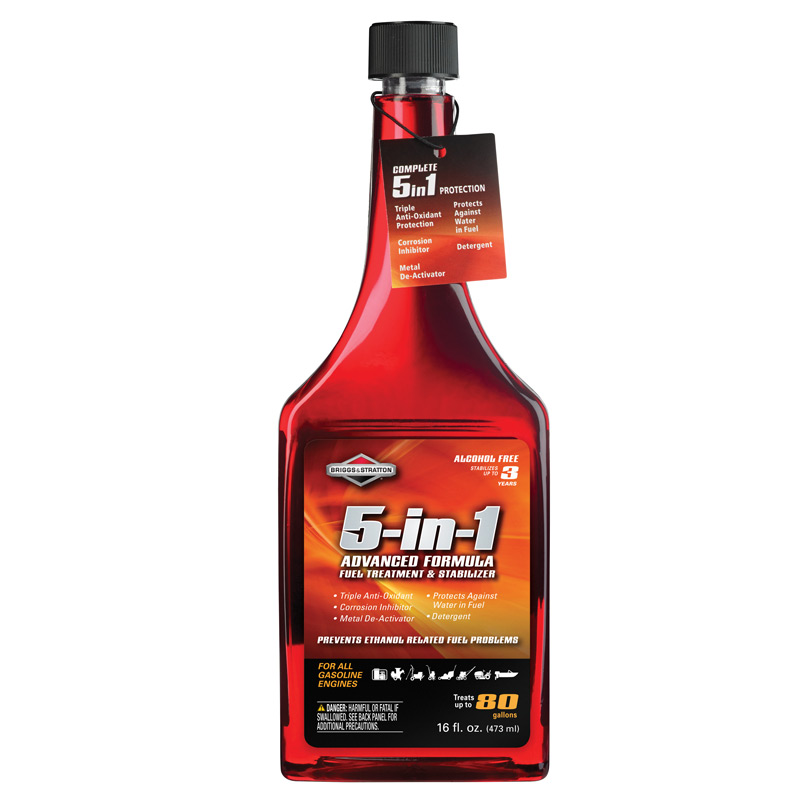What is the best fuel type for lawn mowers and small engines?
Looking for the best lawn mower gas or fuel for your outdoor power equipment? Briggs & Stratton experts share their tips for choosing the right fuel type and proper storage tips to keep your small engine running at peak performance.
What Is the Best Small Engine or Lawn Mower Gas?
Fuel Storage Safety Tips
![]() WARNING: Fuel and its vapors are extremely flammable and explosive. Always handle fuel with extreme care. Find all Engine Safety Warnings
WARNING: Fuel and its vapors are extremely flammable and explosive. Always handle fuel with extreme care. Find all Engine Safety Warnings
Fuel for your lawn mower or outdoor power equipment must meet these requirements:
- Clean, fresh, unleaded
- A minimum of 87 octane/87 AKI (91 RON); If operating at high altitude, see below
- Gasoline with up to 10% ethanol (gasohol) or up to 15% MTBE (methyl tertiary butyl ether), is acceptable. Some fuel stations are now selling gasoline with up to 15% ethanol. This E15 product is not recommended or approved for use in small engines.
- A canned fuel product such as Briggs & Stratton Advanced Formula Ethanol-Free Fuel can also be used. This fuel combines ethanol-free unleaded gasoline with a fuel stabilizer to prolong the life of the fuel.
Note: LOOK BEFORE YOU PUMP! Do not use an unapproved fuel type (such as E85 ethanol gasoline) or modify your Briggs & Stratton engine to run on alternative fuels. These actions can cause damage to small engines and will void your Briggs & Stratton warranty.
All fuel is not the same. If starting or performance problems occur in your lawn mower or equipment, change fuel providers or change brands.
Fuel Recommendation for High Altitude Climates
At altitudes over 5,000 feet (1524 meters), a minimum 85 octane / 85 AKI (89 RON) gasoline is acceptable. To remain emissions compliant, high altitude adjustment is required. Operation without this adjustment will cause decreased performance, increased fuel consumption, and increased emissions.
Operation of the engine at altitudes below 2,500 feet (762 meters) with the high altitude kit is not recommended.
Mixing Oil & Fuel for Small Engines
- 4 Stroke Cycle Spark Ignited Engines: Do not mix oil in gasoline, or modify engine to run on alternate fuels. This will damage the engine components and void the engine warranty.
- 2 Stroke Cycle Spark Ignited Engines: Always mix a high quality, 2-cycle oil, such as Briggs & Stratton lawn mower oil, at a 50:1 gas to oil ratio.
Don’t know what type of engine you have? Consults your Briggs & Stratton manual or contact your local service dealer.

Gas will become stale if you are storing your lawn mower or power equipment for more than 30 days. Stale fuel can cause engine damage from acid and gum deposits forming in the fuel system or carburetor. Damage to the carburetor or engine due to bad fuel will void the engine warranty. Keep lawn mower gas fresh by using Briggs & Stratton fuel stabilizer, specially designed for small engines.
With fuel treatment, you don’t need to drain costly gasoline from your small engine to safely store your equipment. Simply follow these steps for proper storage:
- Step 1: Add fuel treatment according to instructions
- Step 2: Run engine for 2 minutes to circulate stabilizer through the fuel system
- Step 3: Store lawn mower or equipment in clean, dry place for up to 24 months
If gasoline in the small engine has not been treated with a fuel stabilizer, it must be drained into an approved container. Run the engine until it stops from lack of fuel.
The use of a fuel stabilizer in the storage container is recommended to maintain freshness. It is also recommended that fuel is purchased in quantities that can be used within 30 days. This will assure fuel freshness and volatility tailored to the season.
For additional information on fuel type, please contact Briggs & Stratton engine experts near you!




